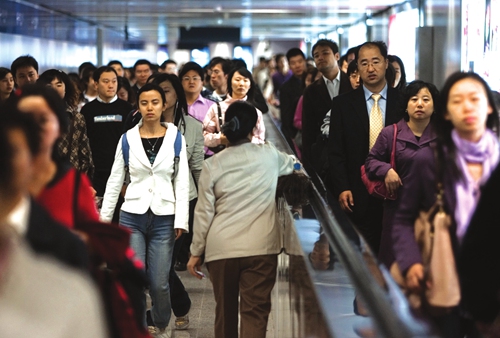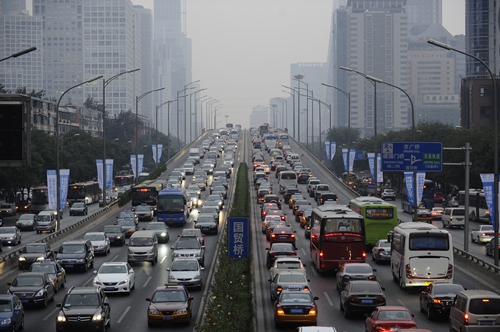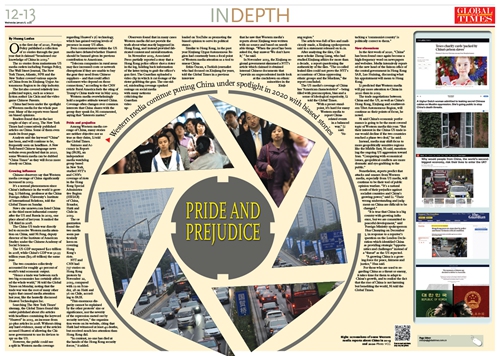HOME >> CHINA
Pride and prejudice
By Huang Lanlan Source:Global Times Published: 2020/1/7 21:18:26
Western media continue putting China under spotlight in 2020 with biased stories

Photo: Li Hao/GT
On the first day of 2020, Foreign Policy published a collection of 10 stories through the past year that it claimed "broadened our knowledge of China in 2019."The 10 stories from mainstream US media outlets including Foreign Policy, The Wall Street Journal, The New York Times, Atlantic, NPR and the New Yorker covered various aspects of China from its Xinjiang Uygur Autonomous Region to its chip industry.
The list also covered relatively less politicized topics, such as science fiction author Liu Cixin and the video game Chinese Parents.
China had been under the spotlight of Western media for the whole past year. Many of the reports were based on biased opinions.
Readers found that in the last couple of days of 2019, The New York Times had consecutively published articles on China. Some of them even made its front page.
Analysts said the keyword "China" has been, and will continue to be, frequently seen on headlines. A New York-based Chinese language news website even predicted that in 2020, some Western media can be dubbed "China Times" as they will focus more closely on China.
Growing influence
Chinese observers say that Western media coverage of China significantly increased in 2019.
It's a normal phenomenon since China's influence in the world is growing, Li Haidong, professor at the China Foreign Affairs University's Institute of International Relations, told the Global Times on Sunday.
News site usnews.com listed China as the third most influential country after the US and Russia in 2019, one place ahead of last year. It ranked the UK third in 2018.
The China-US trade war directly led to excessive Western media attention on China, said Ni Feng, deputy director of the Institute of American Studies under the Chinese Academy of Social Sciences.
The US GDP surpassed $20 trillion in 2018, while China's GDP was 91.93 trillion yuan ($13.08 trillion) the same year.

Photo: Li Hao/GT
The two countries collectively accounted for roughly 40 percent of world's total economic output."Hence a trade war between such two big economies has certainly affected the whole world," Ni told the Global Times on Monday, noting that the trade war was the root of many other topics that caused media attention last year, like the heatedly discussed Huawei Technologies Inc.
Searching The New York Times' sitemap, the Global Times found this outlet published about 180 articles with headlines containing the keyword "Huawei" in 2019, an increase from 30-plus articles in 2018. Without citing any hard evidence, many of the articles accused Huawei of allowing the Chinese government to use its devices to spy on the US.
However, the public could see a split in Western media coverage regarding Huawei's 5G technology, which has gained varying levels of presence in many US allies.
Even commentators within the US media have debated whether Huawei should be banned given its previous contribution to Americans.
"Telecom companies in rural areas may face increased costs or network disruptions if they are unable to buy the gear they need from Chinese suppliers - and that could affect customers who depend on those connections," according to the CNN article Rural America feels the sting of Trump's China trade war in May 2019.
Western media overwhelmingly hold a negative attitude toward China. Coverage often changes over common interests that China shares with the group they speak for, Ni commented, saying that "interests matter."
Pride and prejudice
Among Western media coverage of China, many stories are neither objective nor as true as they claim, Li told the Global Times.
Fairness and Accuracy in Reporting (FAIR), an independent media watchdog group based in New York, studied NYT's and CNN's coverage of riots in the Hong Kong Special Administrative Region (HKSAR) of China, Ecuador, Haiti and Chile in 2019.
The organization found the two media seem particularly keen on covering Hong Kong's riots.
NYT and CNN had 737 stories on Hong Kong protests by November 22, 2019, compared with 12 on Ecuador, 28 on Haiti and 36 on Chile, according to FAIR.
"This enormous disparity cannot be explained by the other protests' size or significance, nor the severity of the repression meted out by security services," the organization wrote on its website, citing that Haiti had witnessed at least 42 deaths, but received much less attention than Hong Kong did.
"In contrast, no one has died at the hands of the Hong Kong security forces," it added.
Observers found that in many cases Western media did not provide the truth about what exactly happened in Hong Kong, and instead provided fabricated content and misinformation.
In November 2019, Associated Press partially reported a story that a Hong Kong police officer shot a rioter in the leg, holding back information of the latter trying to grab the officer's gun first. The Guardian uploaded a video clip in which it cut footage of the rioter grabbing the gun. The one-sided, misleading coverage sparked outrage on social media with many netizens criticizing the Guardian video uploaded on YouTube as promoting the biased opinion to serve its political stance.
Similar to Hong Kong, in the past year Xinjiang Uygur Autonomous Region had constantly been a focal point of Western media attention as a tool to smear China.
Erkin Öncan, a Turkish journalist who had focused on Xinjiang for years, told the Global Times in a previous interview that he saw that Western media's reports about Xinjiang were written with no source and based on unreliable things. "When the proof has been asked for, they answer 'We don't have it,' " he said.
In November 2019, the Xinjiang regional government slammed a NYT's article which claimed it obtained internal Chinese documents that "provide an unprecedented inside look at the crackdown on ethnic minorities in the Xinjiang region."
The article was full of lies and maliciously made, a Xinjiang spokesperson said in a statement released on ts.cn.
After analyzing the files, Chinese scholar Zheng Liang, who had studied Xinjiang affairs for more than a decade, a report questioning the authenticity of the files. "The so-called leaked files could not prove the NYT's accusations of China oppressing ethnic groups and the Muslims," the report concluded.
The US media's coverage of China has "American characteristics" - being filled with preconception, bias and a sense of ideological superiority, Li told the Global Times.
"With a preset standpoint, it's hard for many Western media to report China-related events in a balanced way," Li said. "Attacking a 'communist country' is politically correct to them."
New obsessions
In the first week of 2020, "China" has been found once again become a high-frequency word on newspapers and websites. Media intensively reported the new head of the liaison office of the central government in Hong Kong SAR, Luo Huining, discussing what his appointment will mean to Hong Kong.
Li predicted that Western media will pay more attention to China in 2020 than in 2019.
The trade negotiations between China and the US, as well as China's Hong Kong, Xinjiang and southwestern Tibet Autonomous Region, will continue as their points of focus, he noted.
Ni said China's economic performance is going to be the most covered topic of Western media this year. "But their interest in the China-US trade issue would decline if the two countries reached a phase two deal," he said.
Instead, media may shift focus to more geopolitically sensitive regions like the Middle East, Ni said, mentioning the ongoing US aggression toward Iran. "Comparing with economical issues, geopolitical conflicts are more dramatic and eye-grabbing to the public."
Nonetheless, experts predict that attacks and smears from Western media, especially from US media, will continue to be their tool of public opinion warfare. "It's a natural result of their prejudice against socialist countries and China's growing power," said Li. "Their wrong understanding and judgment on China are difficult to be changed."
"It is true that China is a big country with growing influence, but we are committed to peaceful development," said Foreign Ministry spokesperson Hua Chunying on December 5, in response to a reporter's question on the London Declaration which identified China as providing strategic "opportunities and challenges" instead of a "threat" as the US expected.
"A growing China is a growing force for peace, fairness and justice," Hua said.
For those who are used to regarding China as a threat or enemy, it takes time for them to adapt to China's growth, and to realize the fact that the rise of China is not harming but benefiting the world, Ni told the Global Times.

Global Times